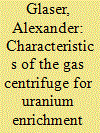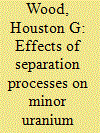| Srl | Item |
| 1 |
ID:
084021


|
|
|
|
|
| Publication |
2008.
|
| Summary/Abstract |
This article presents an analytical model, originally developed in the 1980s, for the gas centrifuge and uses this methodology to determine the main design and operational characteristics of several hypothetical centrifuge designs. A series of simulations for a typical first-generation machine is used to assess the relevance of important breakout scenarios, including batch recycling and cascade interconnection, using either natural uranium or preenriched material as feedstock.
|
|
|
|
|
|
|
|
|
|
|
|
|
|
|
|
| 2 |
ID:
084022


|
|
|
|
|
| Publication |
2008.
|
| Summary/Abstract |
In natural uranium, there are trace amounts of the "minor isotope" 234U in addition to the more abundant 235U and 238U. Uranium irradiated in a reactor and separated from the spent reactor fuel by reprocessing will contain additional minor isotopes. In uranium enrichment, cascades of separating units are tuned to produce the desired level of the isotope 235U, but the levels of other isotopes will also change. Measurement of the assays of the 235U in the feed, product and withdrawal streams of each stage allow the calculation of the stage separation factor for the 235U. The separation factors for the other isotopes may be calculated. In this aritcle, two methods of modeling the separation factors in a way that represents the physics of two enrichment processes, gas centrifuge and gaseous diffusion, are explored. This technique could be a valuable tool in nuclear forensics. For example, it could be important to know the origin of a sample of highly enriched uranium, found either in intercepted material or in explosive debris. Analysis that could point to the enrichment plant where the uranium was produced could immediately identify weaknesses in safeguards and physical security systems.
|
|
|
|
|
|
|
|
|
|
|
|
|
|
|
|
| 3 |
ID:
084023


|
|
|
|
|
| Publication |
2008.
|
| Summary/Abstract |
Over 120 million vehicles enter the United States each year. Many are capable of transporting hidden nuclear weapons or nuclear material. Currently deployed X-ray radiography systems are limited because they cannot be used on occupied vehicles and the energy and dose are too low to penetrate many cargos. We present a new technique that overcomes these limitations by obtaining tomographic images using the multiple scattering of cosmic radiation as it transits each vehicle. When coupled with passive radiation detection, muon interrogation could contribute to safe and robust border protection against nuclear devices or material in occupied vehicles and containers.
|
|
|
|
|
|
|
|
|
|
|
|
|
|
|
|